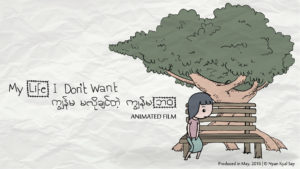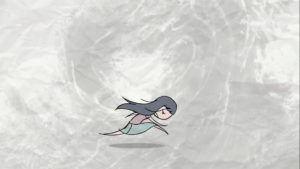My favorite film from last month’s Speechless Film Festival is My Life I Don’t Want, created by Nyan Kyal Say. The appeal of My Life I Don’t Want lies in its simplicity in story and style, though that simplicity also belies much complexity about girls’ experiences in Myanmar and elsewhere.

My Life I Don’t Want is a 12-minute animated documentary that represents the collective experiences of girls’ lives in Myanmar through the childhood of a single female child. Her growing up appears as a series of scenes. The series starts with her joyful welcoming into the world and her growing curiosity about school, but it quickly reveals her secondary status.
This status follows a heartbreaking cycle that begins at home and affects her in school and beyond. When the girl and her brother study in one scene, the girl experiences constant interruptions with household chores such as doing laundry and cleaning floors. She is exhausted and unable to concentrate after all of the interruptions, and her school marks suffer. Her brother studies without interruptions and excels in school. Instead of understanding her struggles, her parents express deep disappointment.
The obstacles grow bigger and more dangerous as she ages. She gets kicked out of homes, boys exploit her for sex, and one man even tries to traffic her. In one scene, she attempts to escape the threats, but they all loom menacingly over her as she runs. She ends up pregnant, standing at an edge with the rain pouring down.

A moment of reckoning, to be sure, but in that, grace appears and offers a hand. For the first time since almost the start of the short, the girl smiles.
The audio and visual styles complement the seemingly straightforward story. In line with the festival’s strong emphasis on visual storytelling, this short uses no specific dialogue. No words are needed.
The animation style also complements the simplicity of the story. Creator Say maintains spare settings with stark backgrounds, such as two desks for the children studying or a bench and tree for the girl meeting a boy. Other elements only appear when necessary to advance the story, such as the girl bringing out a clothes line or a mop and pail during cleaning.

Recent live-action documentaries show girls’ circumstances around the world. While some films celebrate girls’ cultures and their successes, many films focus on their plights and the challenges they face just to survive. They struggle for education, health care, and economic opportunities, while they fight against forced marriage, childbearing, and prostitution.
These documentaries can prove quite traumatic to view. Nick Kristof and Sheryl WuDunn’s Half the Sky visits six countries around the world, showing young girls who have been raped, prostituted, molested, and otherwise exploited. In one segment a girl accuses an uncle of rape only later to lose her home because of her family’s shame. That same segment mentions a 3-year-old being raped as well.
It’s a Girl examines gendercide, or the systematic killing of girls simply because they are girls. This documentary visits India with its practice of selective abortions and visits China with its one (now two) child rule. Both of these countries prefer male children, and the documentary shows these preferences’ effects. Girls end up aborted, abandoned, and murdered.
An opening interview in It’s a Girl spikes this point home. An Indian woman speaks matter-of-factly about killing her newborn daughter. She offers no apologies or remorse. And, chillingly, the recent killing is not her first one.
Both It’s a Girl and Half the Sky make for difficult viewing, and they focus on the cultural implications through multiple interviews and stories. My Life I Don’t Want speaks to these broader themes as well.
But what I really like about My Life I Don’t Want is its focus on a single girl’s story told through her point of view. We identify with her, and the story, animation, and the soundscape all point to that identification. The story is still harrowing, but ultimately, it is her story.